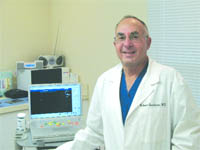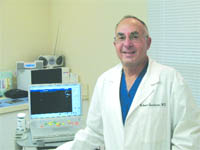
What Lies Beneath
Vascular Surgery Isn’t Just Skin-deep for Dr. Robert Goodman

Dr. Robert Goodman says procedures to help people overcome the discomfort and unsightliness of varicose veins have become increasingly less invasive in recent years.
Dr. Robert Goodman knows what some people think when they hear about removing varicose veins. In a quarter-century in practice as a vascular surgeon, hes heard it often.
A lot of people out there think were treating just the cosmetic aspect, the spider veins. Those are important, and we do treat the cosmetic aspect, but its not our main focus, said Goodman, owner of Goodman Vein and Laser Center, based in West Springfield.
We treat the bigger varicose veins and the vein systems a little deeper in the leg. We look for the root cause of the problem not just the cosmetic aspect, but whats causing it in the first place. We want long-term results, not short-term.
When someone suffers from a varicose vein, he explained, the blood is not moving through the leg efficiently and recirculating.
And if its not getting recirculated, its not going to the lungs and getting oxygenated, he continued. Its unclean blood. And if it stays in the legs, now you have more volume that youre supposed to, which can cause the fluid to leak out of the vessels into the soft tissues. Thats why you get discoloration or ulcers.
From a clinical perspective, the arteries bring oxygen-rich blood from the heart to the extremities, while veins channel oxygen-depleted blood back to the heart. When the veins become congested with blood which typically occurs in the legs they may manifest as small red, blue, or purple veins on the surface of the skin, which are spider veins; varicose veins are larger, distended veins located deeper under the skin.
Goodmans work has ranged from varicose-vein treatment to arterial-bypass surgery and stroke-prevention surgery, but in recent years, he has directed more of his attention toward veins.
As technology has improved over the past 10 years, my interest in the vein side has increased, and my focus has shifted more to that area, Goodman said. I still do arterial work and enjoy doing that, but my focus has generally moved to the vein side.
Likewise, that new technology has made vein surgery more palatable to people who suffer from varicose veins and other conditions.
What before was a very rough operation the old-fashioned stripping and ligation has become, with the advent of lasers, a very sophisticated, outpatient procedure thats safer and has less risk and less recurrence than the old-fashioned operation, he said.
In this issue, BusinessWest pays a visit to Goodmans office, where healing is not just skin-deep.
Laser Precision
Doctors have been treating varicose and spider veins for long before Goodman entered the field, and there was never a shortage of patients who wanted to look and feel better, even though the procedure was typically more invasive and painful in the past than it is today.
The patients have always been there, he said, but the technology has improved and increased in scope, and has let us become more sophisticated in our diagnosis and treatment. In the old days, doctors might even say, theres nothing we can do for your legs; wear stockings and deal with it. Nowadays, were able to say, we believe your legs hurt, and this isnt cosmetic, and we can help you.
The aftermath of surgery has changed for the better, too. You dont miss any work; theres no downtime, he said. In the old days, youd have to rest for two weeks, and you felt miserable. Now, patients walk right out of here, and we encourage them to go to the mall and walk around. We want them back at work the next day. Its a much less invasive procedure.
Heres why: vein stripping, as its known the dominant way to treat varicose veins before the new wave of technology involves actually opening the leg and surgically removing the offending veins. Thats still an option for some patients, but most also have the options of sclerotherapy and laser treatment.
Sclerotherapy, which can be used to treat both varicose and spider veins, employs a tiny needle to inject a medication that irritates the lining of the veins. In response, the veins collapse and are reabsorbed, and the surface veins are no longer visible. Goodman can also perform ultrasound-guided sclerotherapy to treat veins far enough below the surface of the skin that they would otherwise require surgery.
Endovenous laser treatment, meanwhile, is another alternative to surgical stripping of the greater saphenous vein, the large, superficial vein that runs along the thigh and leg. A small laser fiber is inserted, usually through a needle stick in the skin, into the damaged vein. Pulses of laser light are delivered inside the vein, which causes the vein to collapse and seal shut.
We can accomplish the same thing as stripping without all the trauma, he said. It takes 20 minutes, and the patient can drive himself home. Theyre fully ambulatory, and can be back at work the next day.
Ready to Run
Goodman, who is board-certified as a vascular surgeon, said that expertise gives him a diagnostic advantage over other doctors, including general surgeons and dermatologists, who perform vein work.
The symptoms arent just cosmetic, he said. You might have heaviness, tightness, or swelling and itching because the fluid is leaking into the skin. There are a lot of symptoms that go along with this that a lot of people dont recognize. Restless leg syndrome can be due to vein disease. Theres a lot going on here.
Our focus is on the medical aspects of vein disease. If someones leg is bothering them, we take that seriously. By treating the veins, you can significantly improve circulation, and that leads to better leg health while youre improving the circulation of blood throughout the body. So, medically, there are huge advantages to doing this.
The job satisfaction isnt bad, either.
Its a lot of fun, Goodman said. Its very interesting from a technical standpoint, but the most exciting thing about this job is seeing people who sometimes dont even realize how bad their legs were, and then after the procedure, they say, oh my God, thats great. Youre helping people who werent getting help before.
Joseph Bednar can be reached at[email protected]





